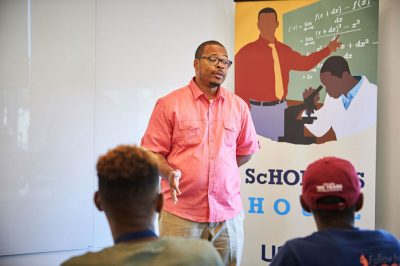Times Colonist (Writings about gifted education by Professor Joseph Renzulli is mentioned in article)
Staying in College to Help Others Graduate
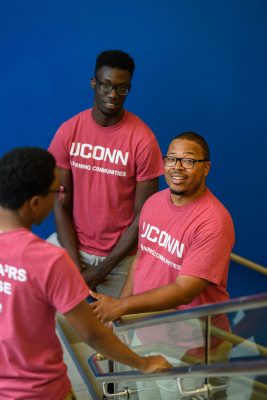
Editor’s Note: The following piece, authored by Julie (Stagis) Bartucca ’10 (BUS, CLAS), was originally published in UConn Magazine’s Fall 2017 Edition. View the original story on the UConn Magazine website.
Erik Hines is passionate about helping black male students succeed at UConn. The assistant professor in the Neag School of Education says he is on a mission to help attract and retain African-American male students.
As faculty director of the new learning community ScHOLA²RS House, Hines hopes to gain a deeper understanding of the variables that influence positive academic and career outcomes for black males, the subject at the heart of both his day-to-day counseling work and his academic research. (ScHOLA²RS stands for Scholastic House of Leaders in Support of African-American Researchers & Scholars).
“We want to cultivate all of our students to be the best and brightest.”
“He is all in,” says Sally Reis, the former associate provost who brought Hines in to work on the newest of the University’s learning communities. “He is completely dedicated to these young men, focused on their graduation from UConn and their success in graduate school and work. He is passionate, committed, and a remarkably strong mentor.”
Born and raised in Tampa, Hines decided to become a school counselor while attending community college there. He went on to earn his bachelor’s in social science education at Florida State University, his master’s in education for school counseling at the College of William & Mary, and his Ph.D. in counselor education at the University of Maryland. He joined the UConn faculty in August 2014.
Hines says he is doing the work he set out to do at age 19. “My career feels purposeful, fulfilling, and empowering. All I think about now is solutions for improving the graduation rate for black males, recruitment of black males in STEM and career fields in which they are underrepresented, and how we help first-generation and other vulnerable populations be successful, too.”
We caught up with Hines over the summer in his Gentry Building office, which overlooks a grassy, tree-lined knoll next to The Benton.
Q: You work with graduate students, preparing them to become school counselors. How has educating them changed with new challenges, such as social media, cyber bullying, and climbing rates of suicide in adolescents?
Hines: Counselors’ goals still are variations of making sure students get their needs met socially and emotionally, even outside the school walls, and accountability — ensuring that students not only understand what they need to know to get to the next grade, but also think long-term: What will life be like post–high school?
I would say school counselors are needed now more than ever. When we were in the space race, after Sputnik, the federal mandate came to put in school counselors to identify the best and brightest in science and math [Title V of the National Defense of Education Act, 1958]. Now, we want to cultivate all of our students to be the best and brightest.
Q: Neag’s school counselor program emphasizes working with underrepresented students. What are some of the tools that you teach to specifically work with those populations?
Hines: We train students to look at the data, as well as how to collect data of their own through observations in classrooms, surveys, reading articles. We teach them to find literature that supports what they want to do and to address what the data is telling them.
Hines: In my School Counseling Development and Evaluation course, students do a mock advocacy project. They use the U.S. Department of Education’s Civil Rights Data Collection website to look at a local school district. They look for gaps, disaggregating the data by factors such as race, socioeconomic status, and gender.
Say an AP algebra II class has 20 students, and 5 are female. There’s obviously a gender imbalance. So students try to figure out why: they can interview teachers and students and look at the process by which students are chosen to take the class. We discuss best strategies for how to advocate for all students to be eligible for these types of programs and courses, maybe advertising the course to girls, or encouraging the school counselors to talk to students about it. Maybe the teacher needs more culturally responsive training to understand how to promote equity in the classroom.
Imagine an educational pipeline from pre-K all the way to graduate school. We are trying to make sure that we close all the leaks in the pipeline. The leaks can be under-resourced schools, teachers not adequately helping students get their needs met academically, and so on. We want to partner with teachers to help them best work with students, and vice-versa.
Q: What sort of pipeline got you to where you are?
Hines: I am forever grateful for the education I received in the great state of Florida. I went to mostly public schools. I went to a community college. And I think being in community college helped me really reflect on my life, because I didn’t do so well my first semester, but it encouraged me to think about what I really wanted to do that could be impactful as a job or career. Of course, my mother was on top of me saying, “You can’t be in college forever.”
Hines: Yes, I did. Yes! Even at times from my bachelor’s to master’s, she told me I needed to get a job. Don’t think she didn’t say that. “You’re going back to school again? You need a job!”
I thought about my strengths, I thought about what I could do, I thought about what I would be fulfilled by doing. I was helping in my local church at the time as a Sunday School teacher. And I was like, oh, I like kids. And then I really thought about my life and what I felt I didn’t get or I needed more of [growing up]. I think in high school, if I really had more people to push me, or I knew about more of the programs available to me, I could have been more successful.
My junior high school counselor, Mr. Robert Davis, stands out though. He was always trying to provide opportunities. He was very engaged with students. He took students on field trips to New York, for instance. Remembering that helped me think, “I want to be a school counselor.”
Q: Was it a straight path?
Hines: I started by going through computer science and business as majors, thinking I wanted to make a lot of money. Then I realized what I really wanted to do was help students develop their potential.
Hines: At Florida State University I met two of my mentors, Dr. Lee Jones, who has since passed away, and Dr. James L. Moore III. [Moore is now interim vice provost for diversity and inclusion and chief diversity officer at The Ohio State University.]
Because of them, I was in the Brothers of the Academy, an academic organization for black men who aim to be tenure-track faculty or academic administrators. That helped me think about how we best help African-American students, and students in general who need help.
Q: How did the idea for ScHOLA²RS House develop?
Hines: Administrators looked at the data — when we talk about advocating, again, we have to look at what the data is saying. And the data told them that the graduation rate for black males at UConn was 55 percent, where our other populations — men, women, Asian, Latinx, white, black women — they were hovering in the high 70s and low 80s. And UConn’s overall graduation rate at the time, 2012–2013, was at 83 percent. They decided that a black male learning community could be instrumental in helping black men.
Currently, at any given time, there’s between 450 and 500 black males on campus, from freshmen to seniors, and there’s 18,000 to 19,000 students on the Storrs campus. So you can imagine, the population is that small, and only half of them were graduating. Something needed to be done.
How do we as a community, how do I as a professor, a father, a teacher, a mentor, an African-American male, help other young men be successful, transcend some of these issues, and not get too bogged down?
Hines: Yeah! I was focused on the academic achievement part. So I was like, “Oh, this is great!” Because it was crazy that the graduation rate was 55 percent. Nationally for black males, it’s 34 percent, so we’re actually doing better because our institution is more selective, and a lot of our black men are coming from the top of their high school classes. Still, imagine that you graduate salutatorian or valedictorian from your high school, and then you look at that rate and think, “UConn may not be a viable option for me to complete.” That’s problematic.
I was naive to the fact people would be concerned about black men living together.
Hines: Some students were hesitant; some wanted to see what it was about. Of course there was some racist propaganda, some students who were African-American who thought it was segregation. I had to combat the stereotype. What is problematic with black men living together? We have other groups living together on campus [WiMSE, or Women in Math, Science, and Engineering, is an all-female learning community, for example.]
To me, [if that’s seen as a problem], then we need to challenge our paradigm of what we think about black men. This should be something that — and I applaud the University of Connecticut — we have to jump on, be at the forefront. We have to take on some of these challenging issues that may not make everyone happy.
Q: Our University spokesperson said she was so shocked by some of the nastiness that you heard from people on the internet. But she said you weren’t shocked by it.
Hines: I’m not. I live and breathe being an African-American man every day. Sometimes I do get those looks; I have been searched unlawfully; I have been questioned about my intellect. I stick with data and I look at the bigger picture: How do we as a community, how do I as a professor, a father, a teacher, a mentor, an African-American male, help other young men be successful, transcend some of these issues, and not get too bogged down? I’m not saying ignore it, because I’m not doing that, but sometimes you have to be the bigger person to challenge it.
I believe the University of Connecticut is on the verge of doing something very innovative and I believe we can be pioneers in improving the graduation rate of black men, and showing our fellow institutions how to do that as well.
Staying in College to Help Others Graduate
UConn Magazine (Neag School’s Erik Hines work on improving the graduation rate for black males is featured)
Neag School Hosts Global Sports Mentoring Program Emerging Leader
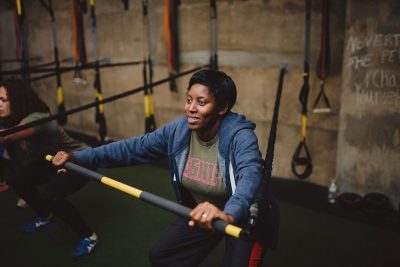
The Global Sports Mentoring Program (GSMP)’s Empower Women Through Sports Initiative is an international initiative co-sponsored by the U.S. Department of State and espnW that partners emerging female leaders from 17 countries with leading executives and experts in the U.S. sports industry. For the second consecutive year, Neag School faculty members Jennie McGarry and Laura Burton will be serving in the coming weeks as hosts.
Now in its sixth year, Empower Women Through Sports recognizes female achievement in sport leadership and aims to empower these emerging leaders to serve their local communities through increasing access to, and opportunities for, women and girls to participate in sports — and, ultimately, ignite change as an ambassador for female athletes around the world.
McGarry and Burton, both professors in the Neag School’s Department of Educational Leadership, were invited back to GSMP to serve as 2017 program mentors for emerging leader Agnes Baluka Masajja, sports tutor at Uganda’s Busitema University and head of the Education Commission with the Association of Uganda University Sports. Baluka Masajja is one of 17 women tapped as 2017 GSMP emerging leaders, all of whom have three or more years of professional or volunteer experience with a sport-based development organization. Each selected emerging leader uses this opportunity to explore a key challenge facing girls and women or people with disabilities in her home country.
“What sports has done for me I feel it can do for girls throughout Uganda. … Sports becomes a platform for a bigger conversation.”
— Agnes Baluka Masajja,
2017 Global Sports Mentoring Program Emerging Leader
‘This is my destiny’
Baluka Masajja has always been a natural when it came to sports. She excelled in all her athletic endeavors, including netball, soccer and track and field. However, despite her achievement in sport, her father pressured her to abandon athletics and focus entirely on her academics.
In her featured GSMP emerging leader profile, she explains how she managed to continue her participation in athletics despite her father’s wishes, “I would have to hide when I ran so he wouldn’t find out,” she says. “I would avoid any national competitions or races where there’d be media coverage because I didn’t want to get in trouble. By the time I got to university, I told my dad, ‘This is my career. This is my destiny.’ So he couldn’t refuse me anymore.”
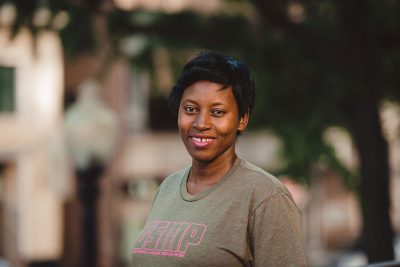
Patriarchal structures in Ugandan society treat men and women very differently in sports. Athletics are seen as part of the natural domain of men. Females in sport often face societal pressure to focus on domestic duties as well as a threat of sexual harassment from male coaches.
Baluka Masajja’s story, however, is different. She broke through barriers and currently serves as a role model for other Ugandan female athletes to do the same. As a sports tutor at Busitema University, she holds positions as a coordinator and supervisor for the university’s 16 athletics programs, only five of which are available for women. The limited number of programs is something she is striving to change. In addition, she serves as head of the Education Commission with the Association of Uganda University Sports, through which she organizes national and international tournaments; coaches workshops for sports trainers and tutors; and hosts seminars and conferences across Uganda. Baluka Masajja also was a coach for the country’s athletics delegation for the 2015 World University Games in South Korea, and will serve in the same capacity for the 2017 competition in Taipei.
According to the U.S. Department of State’s Bureau of Educational and Cultural Affairs website, girls who participate in sports are more likely to have higher rates of school retention and participate in society more. “When women and girls can walk on the playing field, they are more likely to step into the classroom, the boardroom, and step out as leaders in society,” the website states.
For Baluka Masajja, this sentiment rings true. “What sports has done for me, I feel it can do for girls throughout Uganda … Sports becomes a platform for a bigger conversation,” she says. As a GSMP emerging leader, she adds, “I hope to develop skills related to management and business that will help me contribute to economic growth. I also hope to learn about U.S. sports and nonprofit environments so I may implement similar ideas at home.”
After attending this week’s annual espnW: Women + Sports Summit in California, an event that unites female athletes, leaders in sports, and other industry leaders, Baluka Masajja will arrive at UConn to spend three weeks immersed in various learning and networking experiences with McGarry and Burton as her host mentors, who are both experts in gender issues in sport, specifically with marginalized ethnic and socioeconomic groups.
The Neag School will welcome Baluka Masajja at the Department of Educational Leadership General Meeting from 9:45 a.m. to noon on Friday, Oct. 6, in Gentry Room 142 on the UConn Storrs campus, and will share more information on this and other GSMP-related activities in the coming weeks.
Learn more through this featured GSMP video or visit the U.S. Department of State’s GSMP website. Or, check out GSMP on Facebook. Read more about Agnes Baluka Masajja here, and view more photos of Baluka Masajja’s visit to UConn here.
Related Stories:
What We Know About Career and Technical Education in High School
Brookings Institute (Research on career and technical education by Neag School’s Shaun Dougherty is covered)
#TakeAKnee Is Only Symbolic; Economic Activism Is the Real Black Power Salute
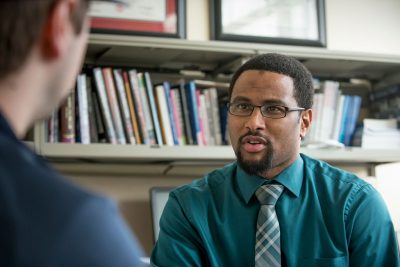
Over recent weekends, several NFL teams have engaged in public demonstrations to show their solidarity in response to President Trump’s recent comments about how owners should respond if players follow Colin Kaepernick’s kneeling action during the playing of the Star-Spangled Banner. Several teams chose to kneel during the anthem in direct objection to the President’s comments. Most of another team decided against being on the field until after the anthem ended. Numerous team owners locked arms with players, while others offered public statements expressing support of their players.
Despite the symbolic nature of these demonstrations, they are just that: symbolic. Let’s be clear about what these demonstrations were and were not:
- They were a sign that these players and select owners have a modicum of consciousness of and consideration for the blatant disrespect of players’ rights to engage in peaceful protests.
- They were a sign that sport can be useful as a unifying force in our society, even while differing perspectives exist.
- They were a sign that the NFL is committed to maintaining business as usual amidst tumultuous political times.
The multiple impacts of these demonstrations are not mutually exclusive (either positive or negative).
However, it is important to understand that these demonstrations were not a form of activism.
Activism through sport has manifested in symbolic gestures, sport-based challenges, and grassroots efforts. Yet the most powerful form of activism within a capitalist society is economic activism.
Kaepernick’s decision to take a knee last year was activism because it disrupted the social order, drawing attention to vast inequalities and injustices in our society and issuing a direct call to action to all U.S. citizens — particularly lawmakers, judicial officers, and law enforcement — to be more reflective and prudent in their roles in serving communities that have been historically and contemporarily disadvantaged.
The actions by the NFL teams and their owners this weekend reflect what American author Ibram X. Kendi has described as protecting their self-interests. Make no mistake: The NFL is not primarily concerned with promoting and securing justice for all, but instead with maintaining its economic standing. It is no wonder the same owners who were silent on, or outright condemning of, Kaepernick’s initial act of activism are now offering support to players’ rights to protest peacefully and express their political views. What caused the sudden shift in opinion or tenor? Low NFL ratings signaling a decline in viewership and growing public discontent with disdainful rhetoric and perceived apathy from team owners.
Activism through sport has manifested in symbolic gestures, sport-based challenges, and grassroots efforts. Yet the most powerful form of activism within a capitalist society is economic activism. Numerous NFL fans have engaged in economic activism by diverting their viewership and overall consumption away from regular season games this year. Although not activism, players’ unions in the past have utilized strikes as a means of leveraging their power in negotiations with their teams.
Within the current context, symbolic activism is helpful, but economic activism is the real Black power salute. Black males constitute 70 percent of the NFL, and the causes for which Kaepernick kneeled impact the Black community disproportionately. So these players would make a more powerful statement if they leveraged their economic power to achieve certain aims — whether the aim is to eliminate the overt discrimination against Kaepernick due to his political stance, to push for more substantive changes in the NFL’s stance on proven domestic violence offenders, or to champion their role in promoting social justice in the broader society. When money is impacted, change will follow.
Symbolic gestures garner attention, but economic activism stimulates substantive change. My hope is that NFL players will decide to do more than take a knee, lock arms, and raise a fist for a salute and instead exercise their economic strength to drive the change we really need in sport and society. There is a point when playing the game does not outweigh championing social justice.
Joseph Cooper is an assistant professor of sport management in the Neag School of Education at the University of Connecticut.
Professor Emeritus Vincent Rogers Bestows Innovation Grant
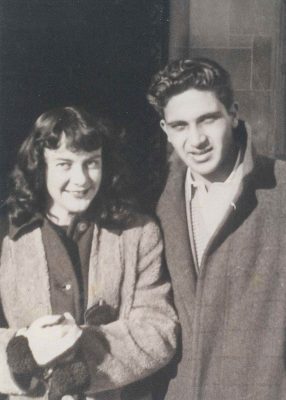
When Neag School of Education professor emeritus Vincent Rogers’ daughter and her husband — both schoolteachers — received a $5,000 grant to study educational techniques in New Zealand, Rogers himself was inspired to add to his family’s existing Neag School fund with something similar for teachers in Connecticut.
Rogers recently announced a planned bequest to the Neag School, designating a legacy gift of $125,000 to expand the Rogers Educational Innovation Fund in support of innovative projects carried out by teachers in Connecticut. Through his gift, elementary and middle-school teachers across the state will be able to apply annually for a $5,000 gift for use in the classroom.
Rogers’ daughter and son-in-law, teachers at the Pine Point School in Stonington, Conn., used the grant they had received to visit schools in New Zealand, networking with educators and learning techniques that would, in turn, enrich the school where they teach.
Rogers, now 90, recalls how the grant impacted them and, ultimately, inspired him personally to expand a Neag School award he and his wife previously established, that will now, he says, “be an open-ended initiative for the teacher … to come up with a really creative idea that would help them, the school, and the children.”
Giving Back to Teachers
Rogers and his now late wife, Chris, also a longtime educator, previously established a fund at the Neag School through which elementary school teachers in Mansfield, Conn., could apply annually for a $1,000 grant to enrich their classrooms. Over the years, eight grants were made to local schools.
Chris Rogers, who passed away in 1999 from complications after a 30-year battle with multiple sclerosis, inspired many children over her three-decade career, but did not let her disability keep her from making a difference, says her husband, who calls her “the greatest teacher the world ever saw.”
Vincent Rogers has announced a planned bequest to the Neag School, designating a legacy gift of $125,000 to expand the Rogers Educational Innovation Fund in support of innovative projects carried out by teachers in Connecticut.
Rogers’ additional gift will be open to elementary and middle-school teachers across the state of Connecticut to “support research and programs for the collaborative work of classroom teachers and the Neag School of Education,” and award recipients will have the freedom to use the award in any way they see fit. Rogers, who spent four decades teaching and writing about education techniques, led the Neag School’s Department of Curriculum and Instruction and served on its faculty, retiring in 1990.
A History of Inspiration
A third-generation Italian growing up in New York, N.Y., Rogers had not traveled much beyond the city during his youth. But when a high school friend who went on to Cornell University invited Rogers to see his college campus, Rogers found himself inspired.
“That visit changed everything,” he says. “The sheer beauty of the campus, the academic atmosphere, the intellectual atmosphere … Those guys walked across the campus at 10 in the morning with a little folder under their arm, giving lectures.” He recalls thinking: “I’m interested in that job. How do you get that job?”
Accepted at Cornell as a history major, Rogers was drafted in his second year by the U.S. Army and originally slated to serve in combat overseas. But Rogers, a jazz musician during his high school days, was then reassigned to play trumpet in the West Point Military Academy band. After playing for West Point for nine months and completing his three-month basic training, Rogers qualified for the G.I. Bill, which allowed him to return to Cornell with his education costs covered.
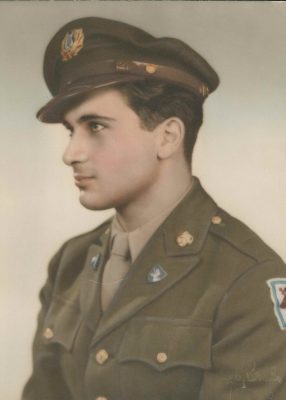
Cornell provided more than a degree for Rogers; he also met his wife, Chris, there. Following college, they both taught in the Westhampton Beach, Long Island, school system for several years before Rogers was made school principal at James Port School on Long Island. It was a role he believes he was given not due to his natural leadership ability, but because he was a man.
“I was a good teacher, but hadn’t been there that long,” he says. “Most of the faculty were women, and Chris would have made a better principal.”
While leading the school in Long Island, Rogers took graduate extension courses through Syracuse University. One professor took a liking to Rogers and suggested he go to Syracuse for a graduate fellowship program.
“Here was my way to get what I wanted: to be a college professor,” he says.
Against his parents’ wishes, the Rogers family went to Syracuse. “My family [thought] that I was crazy to leave a job like a principalship. Back in the 1940s, you didn’t leave good, steady jobs,” he says.
Eventually earning a doctorate in history in 1949, Rogers was hired as an assistant professor at Syracuse — fulfilling his dream and starting his long-awaited career as an academic.
Open Education
Rogers taught at Syracuse for a number of years and was then recruited to the University of Massachusetts at Amherst. Through colleagues, he later connected with faculty at Johns Hopkins University, which had a center for international studies in Bologna, Italy. There, he participated in its American teachers abroad program, a six-week opportunity for Rogers and fellow faculty from history, economics, sociology, and education, which turned into two summers abroad for Rogers and his family.
University of Minnesota came calling next, where they spent the next five “incredible” years. During this time, the Fulbright Program came into the picture for Rogers when an administrator of education from England, who had been following Rogers’ published works, suggested he apply for a Fulbright.
“He visited my classrooms, and we had long conversations about education in general,” recalls Rogers. “He seemed to think I was just what they needed.”
Rogers’ Fulbright research targeted child-centered learning in British schools, which focused attention on children doing and being active in the classroom, versus being lectured to. His work led to the publication of a book called The Social Education of British Children (1968, Heinemann Publications). The Fulbright ended, and he returned to University of Minnesota. Through his time, he continued publishing about child-centered education, also known as open education.

This work sparked the attention of many institutions, including that of the University of Connecticut, which sought an individual to lead the nation in developing child-centered education in the U.S. as chairman of the curriculum and instruction department in the School of Education. Rogers led the department for five years and continued to publish and travel the world, speaking and writing about child-centered education until returning to a faculty role and continuing his research.
“Everyone was interested in open education, and I was giving lectures everywhere,” Rogers says. “I’m a firm believer that if you want to improve and get new ideas, it’s best not just to read about them, but to go and see it happen.”
“Vin was absolutely one of the very best department heads I ever knew,” says Neag School professor emeritus Gil Dyrli. “He led by example through conducting groundbreaking research, publishing significant books and articles, and presenting keynote addresses at major professional conferences.”
“He was a world leader in international education and the education movement known as ‘open education,’ and wrote the definitive book in the field,” Dyrli adds. “As I travelled the country throughout my career, representing UConn and doing staff development, a common question was ‘Do you work with Vin Rogers?’”
Innovation Back Home
In Connecticut, Rogers followed through on his innovative work. He connected with a fellow School of Education faculty member, the late A.J. Pappanikou, whose focus was on special education, with whom he partnered to ensure that future educators were getting hands-on experience in urban school settings.
Together, they coordinated about 20 UConn students to do their student teaching in New Haven, Conn., where, Rogers says, students had an opportunity to get a view of schools beyond suburbia — a rare and innovative practice at the time.
“His many students have gone on to important positions at state, national, and international levels in public and private education,” says Dyrli. “His original contributions and seminal ideas continue to be worth exploring, and thanks to the internet and online resources, they are more accessible than ever.”
With his newly announced bequest to the Neag School, Rogers will now be passing that spirit of innovation to yet another generation of students, giving teachers in Connecticut the opportunity to enact innovative projects of their own in elementary and middle-school classrooms across the state.
Learn more about the Rogers Educational Innovation Fund — and apply for the grant — at rogersfund.uconn.edu. Consider a gift in a support of the Neag School.
Would a Proposed School Choice Proposal be Constitutional in NH?
Concord Monitor (Neag School’s Preston Green is interviewed about the constitutionality of school choice proposals in New Hampshire)
10 Tips on Preparing for Your Child’s College Search

For families looking to assist their high school grads in finding the best path for a fulfilling future, there are not only many resources available, but also many choices available when it comes to a postsecondary education — from universities or trade schools to technical or art schools. It can be a complex and stressful time for caregivers and their children. This might be especially challenging for first-generation students who are the first in their families to attend some type of postsecondary institution. It’s never too early to start thinking about that transition, as there is so much to consider in making this very important decision.
To start, school counselors at your child’s school can help make the journey less stressful and have many resources at their disposal to provide assistance to students as early as kindergarten. Research shows that the earlier students, especially first-generation students, start to think about pursuing education at a postsecondary institution, the more likely they are to attend one — or two, or three. Let’s not forget about graduate school!
Research shows that the earlier students, especially first-generation students, start to think about pursuing education at a postsecondary institution, the more likely they are to attend one.
It is never too soon to start thinking and preparing for the day when your little pumpkin turns into a college kid. Here are some suggestions for adults and their aspiring postsecondary students:
- Start early. Junior year is not early! Let’s start in kindergarten and the question “What do you want be when you grow up?” It doesn’t matter what the answer is, by the way; it just matters that little kids think about their future in a fun, magical way and possibly refine it as they get older. Who cares if they want to be the tooth fairy? She has a bundle of money!
- Statistics show that the earlier a child sets foot on a college campus, the better. No, I am not suggesting that you send your kindergartner to college next year. Just a visit to the campus will suffice. Field trips to colleges and universities help students envision themselves on a college campus. They see other students who look like them and realize that they can belong there, too.
- Encourage your child’s school to incorporate college-going themes into the school system. Perhaps Fridays can be a “wear your college sweatshirt to school day,” or teachers could hang pennants from the school they attended in the cafeteria or classroom. One of the funniest things that happened in our past research when we asked high school students how many adults they knew who had a college degree, more than half of them couldn’t think of anyone. HELLO! How about the 50 teachers in the building?
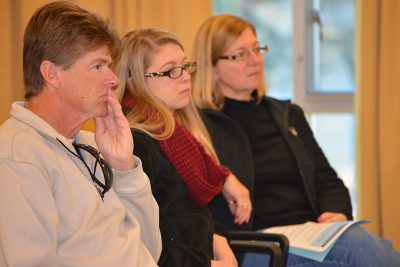
A prospective student and her parents listen to advisors during UConn’s Open House event at the Neag School. - I know, you can’t concentrate because all you are seeing are tuition number signs floating through your head! Don’t judge a school by its tuition price tag. A postsecondary education can be expensive. But before you knock off a prestigious university from your list, make sure you look into the financial aid packages that they offer. Fill out the FAFSA. Don’t just assume you can’t afford it. There are financial aid packages that can drastically lower the cost of attending not just in-state schools, but out-of-state ones as well. And don’t rule out getting lucky. I remember hearing of a very prestigious school that needed a trombone player. They searched through their applications and found one. He received a full four-year scholarship to the school.
- Make lists. Make lots of lists. Family members could make separate lists of colleges that they think are a good fit for their potential college-going student. School counselors usually recommend looking at three different types of schools: “safety schools,” where their student is likely to get admitted; “reach schools,” where the student might not get accepted; and “match schools,” where the decision could go either way. If your student has a disability, make sure you consider the services the college provides. And don’t forget about that trombone player; maybe your little pumpkin has a special talent that can be rewarded in the right school!
- Looking at a college or university online is a great place to start before heading out the door for a college visit. If your student would prefer a bustling, big-city atmosphere, he or she might be turned off seeing a college surrounded by cows — or vice-versa.
- Visit the schools — maybe even years before your student applies there. Think about the kid who really wants to go to (insert dream school here), but then gets to the campus tour and says, “Oh, never mind.” How does your student feel on this campus? Can they picture themselves living here for four years? There’s something to be said for “having a good feeling about it.”
- If your student knows what they want to major in, make an appointment with one of the professors in that field. Don’t be frightened; most professors don’t bite. However, if the professor’s name is Dr. Acula, go ahead and run!
- Don’t pick a school because all your child’s friends are going there. Invite your aspiring college-goer to think about who they are and what they want to be. They will always be able to visit friends at their colleges and hang out with them in the summer. Good friends remain good friends forever.
- Remain a dependable source of positivity and encouragement. These can be some of the most challenging moments of your child’s life, and some of the most fulfilling. The days might sometimes feel long, but the years will fly by.
Good luck on your journey!
Rachelle Pérusse, an associate professor of counseling at the University of Connecticut’s Neag School of Education, specializes in school counseling, the achievement gap, and postsecondary transition.
Neag School Welcomes New Faculty Member in Educational Technology
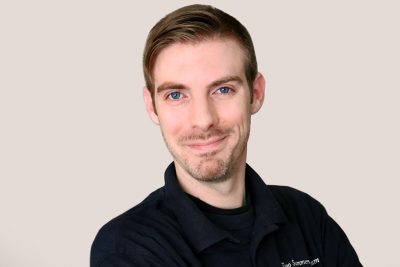
The Neag School of Education this week welcomes Stephen Slota as an assistant professor-in-residence of educational technology, with a joint appointment in the School of Fine Arts Department of Digital Media and Design.
Slota ’07 (CLAS), ’08 MA, ’14 Ph.D. most recently served as an instructional design specialist and game design scientist at UConn Health’s Faculty Instructional Technology Services. He has worked on a variety of game and instructional design projects with such organizations as Arizona State University’s Center for Games and Impact, Intel Corporation, Pfizer, and InSync Training, LLC. A certified biology teacher, he also has experience teaching in Manchester and Coventry (Conn.) high schools.
Slota’s research interests include instructional game design, technology, and education, and he is the co-owner of the Pericles Group, a game development company. He is the co-author of Exploding the Castle: Rethinking How Video Games and Game Mechanics Can Shape the Future of Education (Information Age, 2017), released this fall. He holds a bachelor of science degree in molecular and cellular biology, a master’s degree in curriculum and instruction, and a Ph.D. in educational psychology from the University of Connecticut.
